The total number of private building constructions from approved permits in the province of Samar grew by 19.0 percent, from 221 in 2019 to 263 in 2020. (Table 1)
Residential has the highest number of constructions
Residential building constructions yielded the highest number with 175 projects or 66.5 percent of the total number during the year. This is 37.8 percent higher than that of the previous year. Most or 94.3 percent (165 permits) of the total residential building constructions were single-type houses. (Table 2 & Figure 1)
Non-residential ranks second highest in number of constructions
Non-residential building constructions accounted for 27.8 percent. A decrease of 8.8 percent was observed from the 80 building permits in 2019 to 73 in 2020. The commercial building type projects consisting of 49 approved permits accounted for majority or 67.1% of the non-residential constructions. (Table 3 & Figure 1)
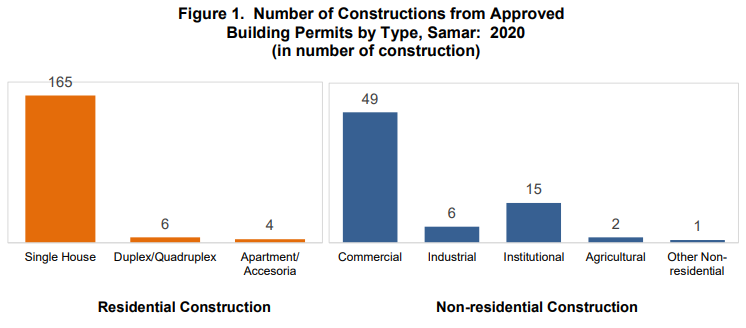
Residential recorded the second highest value of constructions
The total value of construction of private residential buildings in the province amounted to PhP 324.04 million, accounting for almost half or 48.7 percent of the total value of private buildings constructed in 2020. The amount is 30.1 percent higher compared to PhP 249.03 million total construction value in 2019. Single house type yielded the highest share amounting to PhP 305.16 million (94.2 %) of the total value for residential constructions. (Table 4-5 & Figure 2)
Non-residential recorded the highest value of constructions
For 2020, the value of non-residential constructions resulted to PhP 340.33 million accumulating over 51.1 percent of the total value under the same building type. This depicted a 7.4 percent downturn from the PhP 367.68 million value of construction in 2019. Among the non-residential constructions, commercial type has the highest value contribution amounting to PhP 178.23 million (52.6 %). (Table 6 and Figure 2)
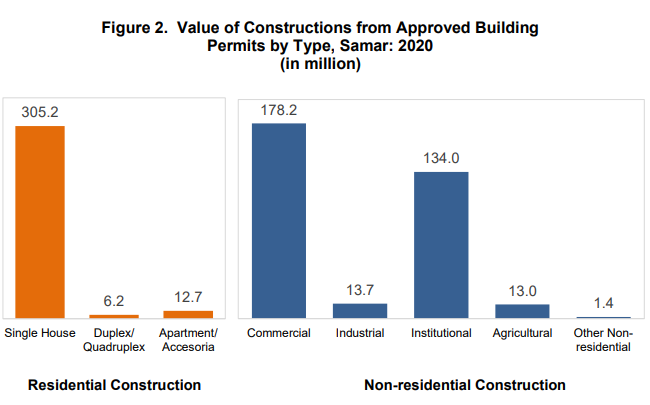
Floor Area
The total floor area of constructions in 2020 accumulated to 56,155 square meters, indicating a decrease of 0.52 percent compared to the total floor area of 56,449 square meters in 2019. (Table 1)
Residential reaches more than half of the total floor area of constructions
Residential constructions reached 31,257 square meters taking up 55.7 percent of the total floor area of constructions in 2020. It is relatively higher by 39.7 percent than the 22,378 square meters recorded in the previous year. Among the types of residential construction, single house type yielded the highest area of about 94.7 percent or 29,595 square meters of the total floor area of constructions. (Table 2)
Moreover, the non-residential construction totaled to 24,795 square meters or 44.2 percent of the total floor area of constructions for the year. This exhibited a decrease of 25.9 percent compared to 33,448 square meters of the same type in 2019. Among the buildings under non-residential constructions, the commercial type acquired the highest floor area at 12,284 square meters (49.5 %). (Table 3)
Average Cost per Square Meter
Average cost of construction contracted
As for the average cost of construction, a total of PhP 11,856 per square meter was generated excluding costs incurred from the alteration and repair, demolition/moving and street furniture/landscaping/signboard. It yielded an increase of 7.3 percent in comparison to the PhP 11,045 per square meter average cost in 2019. (Table 4 & Figure 3)
Non-residential had the highest average cost of constructions
Among types of construction, non-residential had the highest average cost of PhP 13,726 per square meter in 2020.This was followed by the addition to existing type of construction with PhP 13,699 per square meter, and the residential construction type with PhP 10,367 per square meter. (Table 4 & Figure 3)
Duplex/Quadruplex construction was the most expensive among types of residential construction
The duplex/quadruplex type amounted the highest average cost among residential construction types with PhP 11,640 per square meter. Second highest average cost was generated by the apartment/accessoria type of construction with PhP 11,225 per square meter while the single house type ranked the lowest with PhP 10,311 per square meter. (Table 5 & Figure 3)
Commercial type buildings were the costliest among non-residential buildings
Commercial building constructions acquired the highest average cost from all non-residential building types with PhP 14,509 per square meter. This was seconded by the institutional building with PhP 14,501 per square meter in 2020. Meanwhile, the agricultural and industrial type of constructions registered the low average costs of PhP 8,558 and PhP 7,825 per square meter, respectively. (Table 6)
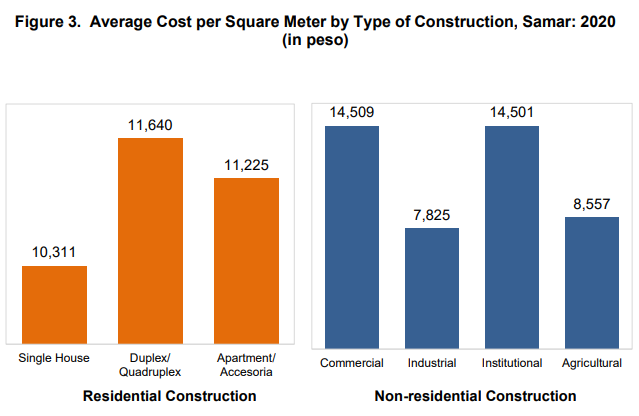
SGD. RIZA N. MORALETA
Chief Statistical Specialist
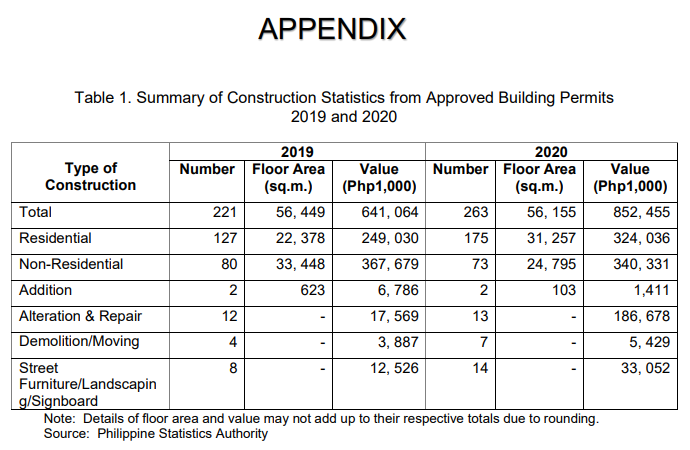
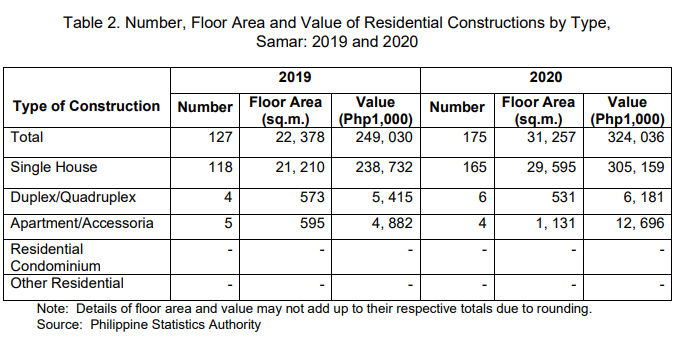


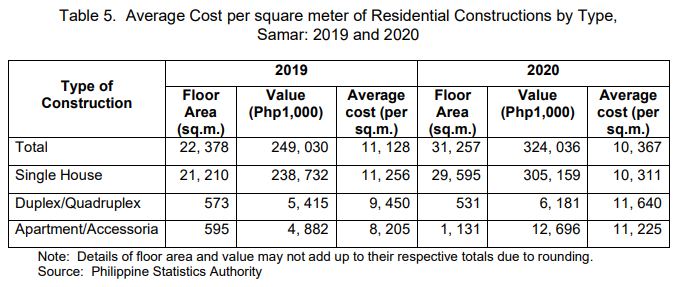
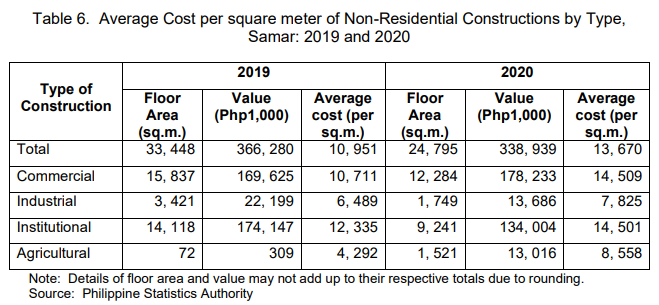
TECHNICAL NOTES
Introduction
This Special Release presents the final data on construction statistics from approved building permits for the year 2019 and 2020. Data are presented in a yearly basis at the provincial level by type of construction.
Scope and Coverage
Private construction statistics from approved building permits relate to new construction and additions, alterations and repairs of existing residential and non-residential buildings and other structure undertaken in all regions/provinces of the country. Presented in this special release were data of Samar (Western) final data of 2019 & 2020.
Source and Information
Data are taken from the original applications of approved building permits collected by PSA Focal Person from Local Building Officials or City/Municipal Engineers from the 26 Municipalities of Samar (Western).
Limitations of data
1. Data on private building constructions refer to those proposed to be constructed during the reference.
2. The completeness of the number of building permits collected relies on the approval of applications filed with the Office of Local Building Officials (LBOs). Hence, private building constructions without approved building permits are excluded in the tabulation of data.
Geographic Classification
Building constructions are classified and presented by geographic area using the Philippine Standard Geographic Classification (PSGC) as of December 2017
Statistics Generated
Construction statistics generated from approved building permit provide monthly data on building construction at the regional and provincial level. The statistics generated are the following:
1. Number
2. Floor area
3. Type of construction
4. Value of construction
Dissemination
Preliminary results of construction statistics are made public in the form of Quarterly/ Yearly Special Releases. The Quarterly Special Releases are reports containing the preliminary results of construction statistics submitted within the cut-off dates for each month. Results are posted 65 days after the reference quarter in the PSA website (www.psa.gov.ph)
Definition of Terms
(Adopted from the Revised and Updated IRR of the National Building Code)
Accessoria – A one or two-floor structure divided into several dwelling units, each dwelling unit having its own separate entrance from the outside.
Addition – Any new construction that increases the height or area of an existing building/structure.
Agricultural Buildings – All buildings, which are used to house livestock and poultry, plants and agricultural products such as barns, poultry house, piggeries, stables, greenhouses and grain mill.
Alteration – Construction in a building/structure involving changes in the materials used, partitioning, location/size of openings, structural parts, existing utilities and equipment but does not increase the overall area thereof.
Apartment - A structure, usually of two stories, made up of independent living quarters, with independent entrances from internal walls and courts.
Building – Any independent, freestanding structure comprised of one or more rooms or other spaces, covered by a roof and enclosed with external walls or dividing walls, which extend from the foundation to the roof.
Building Permit – A written authorization granted by the Local Building Official (LBO) to an application allowing him to proceed with the construction of a specific project after plans, specification and other pertinent documents have been found to be in conformity with the National Building Code (PD 1096).
Commercial Building – Office buildings and all buildings that are intended for use primarily in wholesale, retail and service trades, i.e. stores, hotels, restaurants, banks, disco houses, etc.
Construction - All on-site work done from site preparation, excavation, foundation, assembly of all the components and installation of utilities and equipment of buildings/structures.
Demolitions - The systematic dismantling or destruction of a building/structure or in part.
Duplex – A structure intended for two households, with complete living facilities for each; it is a single structure divided into two dwelling units by a wall extending from the floor to the ceiling.
Floor Area of Building – The sum of the area of each floor of the building measured to the outer surface of the outer walls including the area of lobbies, cellars, elevator shafts and all communal spaces in multi-dwellings. Areas of balconies are excluded.
Industrial Buildings – All buildings which are used to house the production, assembly and warehousing activities of industrial establishments, i.e. factories, plants, mills, repair shops, machine shops, printing press, storage plant, electric generating plants.
Institutional Buildings – All buildings that are primarily engaged in providing educational instructions, hospital/health care, sports, airports and other government buildings, i.e. school, museums, libraries, sanitaria, churches, hospitals, etc.
Non-Residential Building – This type includes commercial, industrial, institutional and agricultural buildings.
Other Non-Residential Building – It includes cemetery structures, street furniture, waiting sheds, communication towers, etc. Other Residential
Constructions – Consist of school or company staff houses, living quarters for drivers and maid and guardhouses.
Repair - A remedial work done on any damaged or deteriorated portion/s of a building/structure to restore its original condition.
Residential Building – A building for which its major parts or more than half of its gross floor area is built for dwelling purposes. This type of building can be a single type, duplex, an apartment and/or accessoria and residential condominium. Residential Condominium – A structure, usually of several storeys, consisting of multiple dwelling units.
Single House – A complete structure intended for a single family or household, i.e. bungalow, 2-storey house, nipa hut, etc.
Street Furniture – These are street structures consisting of monuments, waiting sheds, benches, plant boxes, lampposts, electric poles and telephone poles.
Total Value of Construction – The sum of the cost of building, electrical, mechanical, plumbing, and others. The value is derived from the approved building permit and represents the estimated value of the building or structure when completed.
SGD. RIZA N. MORALETA
Chief Statistical Specialist

